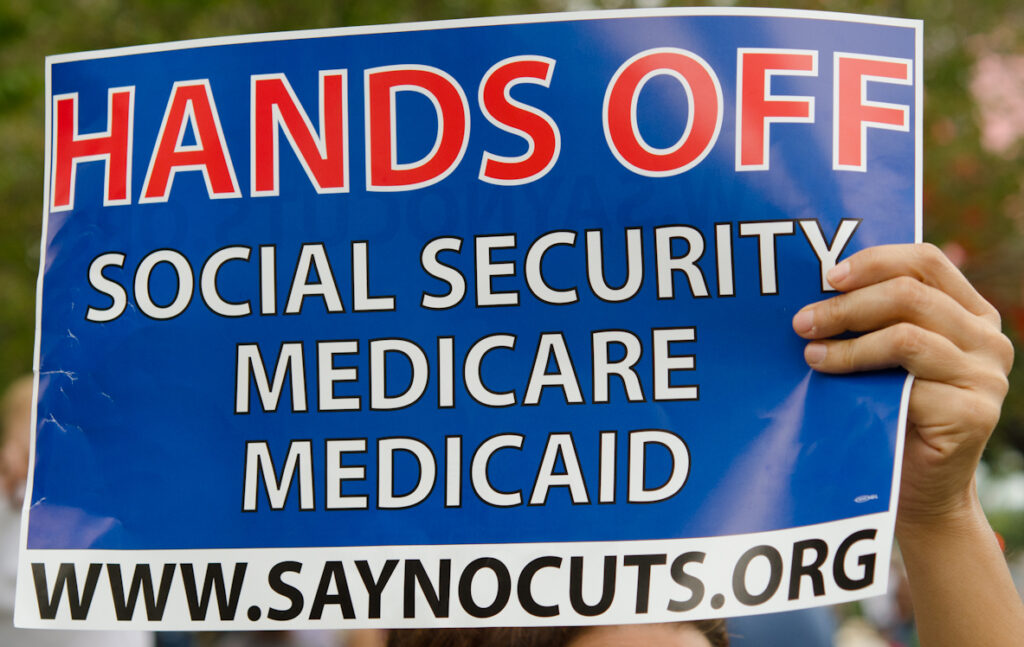
In the last article, we covered how the here-and-now instinct in American politics institutionalized by Franklin Roosevelt combined with the utopian rationalism of the Woodrow Wilson presidency to create the partly beneficial and partly malevolent monster that was the New Deal. In this article, we will cover the further institutionalization of that instinct with Lyndon Johnson’s Great Society, and observe how a plan formulated with the best of intentions so profoundly backfired upon those who planned it. The great sin of the Great Society was the institutionalization of the worship of entitlements, the source of many of our contemporary fiscal and investment woes. We will also observe here the sad fate of the moderate Republicans, and see how their failure in their odyssey contributed to the hyperpolarized partisan mess we know today—dominant conservatives on one side and dominant progressives on the other, with no pro-business/pro-government nationalist middle ground.
In his column, Brooks writes of the Great Society’s extension of the New Deal folly of shortsightedness:
“Third, the Great Society. Lyndon Johnson was right to use government to do more to protect Americans from the vicissitudes of capitalism. But he made a series of open-ended promises, especially on health care. He tried to bind voters to the Democratic Party with a web of middle-class subsidies.
A government that devoted its resources toward future innovation and development now devotes its resources to health care for the middle-class elderly.”
President Lyndon Johnson’s Great Society, like President Franklin Roosevelt’s New Deal, has a legacy of triumph and tragedy, victory and failure. Like the New Deal, the Great Society’s greatest successes occurred over classically Hamiltonian policy areas and their more modern cousins. Great failure came with strong government action in areas like entitlements, healthcare, welfare and, more significantly, the abandonment of temperamentally conservative wisdom in favor of utopian planning schemes. The two examples of these failures came with the design of Medicare and Medicaid, and the undelivered promises of the War on Poverty.
In essence, the problem with Medicaid and Medicare was the same problem as that of Social Security—well-intentioned programs were poorly designed for a society with the demographic trends of the 20th century United States, and poor coordination between the market and the government resulted in rising costs and less efficient deliveries over time. And, more importantly, the resources that went into healthcare entitlements were lump sums, which have their place, but are extreme opportunity costs especially considering that the same money can be invested into productive infrastructure, education, research or other innovative fields, and continue paying back returns for generations on end, while consumable healthcare payments can only be used once. Lyndon Johnson promised a generous healthcare regime for elderly Americans, failing to consider that such an entitlement would wreak havoc on the budgets of future decades, like our own.
But another of Johnson’s promises failed far more visibly, and the reaction was far more extreme. As part of his broader civil rights program, Johnson sought to alleviate the plight of inner-city Black Americans, many of whom lived in urban squalor comparable to metropolises in the Third World. He planned this through a series of social policies promoting greater community integration and solidarity, job training, various volunteer and work programs, expanded programs for welfare and investments in education. These programs differed from Teddy and Franklin Roosevelt’s welfare programs, though, in that they primarily focused on community involvement and were intended to build self-sufficient community networks that could protect members who had fallen upon hard times, rather than provide a hand up from the government for individuals who had lost work.
Predictably, this series of attempts at civil society creation did not have the desired effect. Furthermore, some of the related subsidization programs are widely believed to have exacerbated the breakdown of family structure and social capital among the working poor. It is terribly ironic that – as many conservative thinkers have pointed out – programs designed to help build community destroyed it, and programs designed to help destroy poverty exacerbated it. It is a testament to the Great Society’s adherence to Wilsonian rationalism that, although Johnson understood the pernicious effect of atomistic-individual-based social welfare programs on local communities, the only solution he could endorse to reform and reinstitute the lost communities was through government planning and government action—and it didn’t work. In any case, the great riots across the country in the late 1960s testified to the anger of the inner-city poor over their continued situation, regardless of any policies President Johnson thought could alleviate their pain.
Beyond undelivered promises, irresponsible expansions of entitlements and utopian ideals of government-created local communities, the Great Society indeed had some successful moments. Government-sponsored public art flourished under the establishment of the National Endowment for the Arts and the National Endowment Humanities, and the construction of the Smithsonian Art Museum and the Kennedy Center. Never before had public art been financed so generously.
In a more Hamiltonian manner, Johnson’s Great Society dramatically increased federal funding for education and transportation infrastructure. Billions of dollars flowed into funds to modernize America’s physical infrastructure, including some that went to building high-speed rail on the East Coast. Funds were given to states and cities and other communities with the express purpose of being used on local infrastructure projects. Meanwhile the federal government invested more money and energy into education, providing grants to states to purchase materials and improve their educational climates for their students. This bled into higher education too, and today dozens of departments at various institutions can trace their origins to funds set aside by Johnson’s Great Society.
Finally, the Great Society included programs that began the modern period of environmental conservation, where non-harvestable resources like air and water were given their due protection. Such landmark legislation as the Clean Air Act, the Wilderness Act and the Endangered Species Act were passed as parts of great society legislation, continuing the conservatory tradition of the Roosevelts and ensuring a broadly healthy environment accessible to all Americans.
In sum, the Great Society accomplished many important things, but it didn’t do anywhere near enough to have the momentous impact of the New Deal. It siphoned money to various failing social programs, money that might have been better used for investment in innovation and infrastructure. It highlighted the furthest extent of American Progressivism with all its failures, and it continues to provide crucial lessons for all enterprising Hamiltonians who would be careful not to allow their ideology to go to the extremes of Progressivism. It offered no real new lessons; it mostly repackaged the lessons learned from the New Deal, and emerged as proof that the Democrats, by the 1960s, had not learned the lessons of the 1940s.
One would think that the Republicans, by this time, would have capitalized on Democratic failures to govern effectively and would have brought forth proposals of their own, still progressive in the best sense of the word but more Hamiltonian in mechanism and more conservative in temperament. There were indeed some great moderate Republicans in this time – among them William Scranton, Jacob K. Javits, Henry Cabot Lodge Jr. and Nelson Rockefeller – who did what they could to offer up alternative proposals to the excesses of Great Society Progressivism, cooperating with Democrats on important issues but improving their policies on others.
Alas, the Moderate Republicans of the time were facing their own insurgency from the Right. In 1964, Barry Goldwater, conservative icon, was granted the GOP presidential nomination, capping off a struggle that had been going on for more than a decade between libertarian-Jeffersonian conservatives and Hamiltonian moderates in the GOP. After Goldwater’s nomination, the struggle only became more and more intense, and by the 1980 election the moderates had basically been nudged out of the party, either into oblivion or into the arms of the Progressive Democrats.
Under such conditions, the moderate Hamiltonian Republicans were in no place to put forth policy proposals alternate to those of the Progressive Democrats, as they struggled for control over their own base with the ascendant conservatives. The Progressive tradition of the Democrats went unchallenged by any tradition but the radical conservative one emanating from the Goldwater-Reagan camp. Thus died the power of the Hamiltonian tradition in American politics.
What to do, then? Clearly, Progressivism – what most conservatives today might call ‘Big Government’ – has its lethal downsides, fatal to the perpetuation of a strong, dynamic society and economy. It is excessively rationalistic and nearly utopian in its conception of human nature and its faith in centralized planning. It is far too focused on the here-and-now concerns of popular opinion that it is incapable of setting down long-term strategic consensus. And, it is concerned with consumable entitlements to an unhealthy degree—a degree that leads it to commit undeliverable promises. These three flaws are related to each other, and any one of them alone would be significant to render an ideology unacceptable. But, the combination of them is unthinkable.
We need, therefore, a revived Hamiltonianism for the 21st century. Brooks argues: “We’re not going back to the 19th century governing philosophy of Hamilton… Lincoln [and Roosevelt].” I would disagree. We don’t have to literally place those men on a pedestal and use the policies they used, but we CAN formulate a coherent pro-government, pro-business policy of governance based on the social and economic principles exemplified in the careers of those three outstanding statesmen. Sound finance, federal support for infrastructure, education and innovation, and commitment to broad-based industrial growth are in the interests of all Americans. A strong nation that can stand on its own, replete with entrepreneurial individuals empowered by expanding opportunity, is the America in which we all should want to live. The principles of Hamiltonianism, as Brooks has articulated them, can serve as a roadmap to get us there.
A version of this article first appeared at Independent Voters Network.
The views expressed by the author do not necessarily reflect those of the Glimpse from the Globe staff, editors, or governors.







Leave a Reply